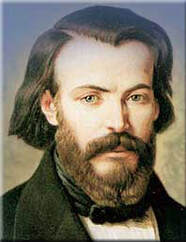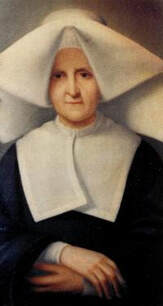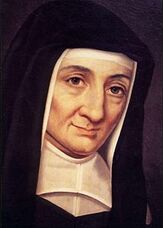HISTORY
The Society’s Birth in Post-Revolutionary France

The Sorbonne, Paris
Frédéric Ozanam left his home in Lyon, France, in the autumn of 1831, for Paris. He registered in the School of Law at the Sorbonne, University of Paris. Frédéric collaborated with Mr. Emmanuel Bailly, editor of the Tribune Catholique, in reviving a student organization which had been suspended during the revolutionary activity of July 1830. They called their new association “The Conference of History.” The group met on Saturdays to discuss various topics, everything but politics.
At one of their meetings, a student challenged Frédéric and the practicing Catholics. He admitted that the Catholic Church had done much good work in the past, but “what do you do now?” Frédéric called for a meeting of five of his friends; they agreed to meet at Mr. Bailly’s office. The date was April 23, 1833, Frédéric’s twentieth birthday. Inspired by their words, Frédéric decided to found the “Conference of Charity” to assist the poor. Emmanuel Bailly, the married layman, was chosen by the six students as their first President. In a short time, they changed their name to The Society of St. Vincent de Paul in honor of their patron.
They also reached out to Sr. Rosalie Rendu, a Daughter of Charity, who had spent her life serving the poor of the Mouffetard District of Paris. It was Sr. Rosalie who introduced Frédéric and his companions to the poor, escorting them into the slums and demonstrating for them how to befriend and minister to those in great need.
Founding and Legacy of the Society of St. Vincent de Paul
The following short film (15 minutes) is presented courtesy of SVDP New South Wales, New Zealand. More historical information can be found below the video.
Our Patrons and Founders
Blessed Frédéric Ozanam
Founder

Blessed Frédéric Ozanam (1813 – 1853) was founder of the Society of St. Vincent de Paul. Frédéric was a husband and father, professor and servant of the poor. He founded the Society of St. Vincent de Paul as a young student with others of the Sorbonne in Paris. Sister Rosalie Rendu, a Daughter of Charity, is considered a mentor of Frederic and of the Society of St. Vincent de Paul as she taught the first members the art of helping the poor and the sick. Frédéric’s writings on social justice anticipated the first social encyclical of our modern times, Rerum Novarum.
Blessed Rosalie Rendu
Founder

Blessed Rosalie Rendu, DC (1786 – 1856) was a Daughter of Charity who served for 54 years in the Mouffetard area, the most impoverished district of Paris. Emmanuel Bailly, the President of the Society, sent the founding members of the Society to Sister Rosalie for guidance and direction. Sending them on home visits, she formed them in the spirit of St. Vincent, teaching them how to serve the poor with respect and compassion.
St. Vincent de Paul
Patron
St. Vincent de Paul (1581-1660) was founder of the Congregation of the Mission, Daughters of Charity, Confraternities of Charity, and Ladies of Charity. A man of deep faith, keen intellect, and enormous creativity, he has become known as the “The Apostle of Charity” and “Father of the Poor.” His contributions to the training of priests and organizing parish missions and other services for the poor shaped our Church’s role in the modern world.
St. Louise de Marillac
Patron

St. Louise de Marillac (1591 – 1660), a contemporary of St. Vincent, was inspired and directed by Vincent’s spiritual leadership. She was Vincent’s collaborator in founding the Daughters of Charity and organizing hospitals for the sick poor, asylums for the orphaned, workshops for the unemployed, championing literacy for the uneducated, and establishing standards for local charities. Louise was a wife, mother, teacher, nurse, social worker and religious foundress.
The Society in the United States
 While historians are not certain about some details, there is no doubt that the Society of St. Vincent de Paul was established in St. Louis, Missouri at the Basilica of St. Louis, King of France, popularly called “The Old Cathedral,” in 1845. Father John Timon, CM, an American Vincentian priest from Pennsylvania, and later Bishop of Buffalo, New York, was the one who brought copies of the Rule of the Society of St. Vincent de Paul back from Dublin, Ireland, to St. Louis. Timon talked to various people about the Society and its wonderful work with the poor. Bishop Peter Richard Kenrick, successor of the first Bishop of St. Louis, Joseph Rosati, CM, asked Father Ambrose Heim to establish the Society of St. Vincent de Paul and be its Spiritual Advisor. Father Heim was known by all for his extraordinary zeal and ministry with the poor. He became known as “The Priest of the Poor.” The first meeting of the Society of St. Vincent de Paul in the United States was held on November 20, 1845, only twelve years after its foundation in Paris. Nineteen of the most prominent Catholic laymen of St. Louis attended. Dr. Moses Linton was elected President, Bryan Mullanphy, Vice President, Dennis Galvin, Second Vice President, James Maguire Jr., Secretary, Patrick Ryder, Treasurer, and Fr. Ambrose Heim, Spiritual Advisor. The Conference was aggregated (formally recognized) by the Society’s International Council in Paris on February 2, 1846.
While historians are not certain about some details, there is no doubt that the Society of St. Vincent de Paul was established in St. Louis, Missouri at the Basilica of St. Louis, King of France, popularly called “The Old Cathedral,” in 1845. Father John Timon, CM, an American Vincentian priest from Pennsylvania, and later Bishop of Buffalo, New York, was the one who brought copies of the Rule of the Society of St. Vincent de Paul back from Dublin, Ireland, to St. Louis. Timon talked to various people about the Society and its wonderful work with the poor. Bishop Peter Richard Kenrick, successor of the first Bishop of St. Louis, Joseph Rosati, CM, asked Father Ambrose Heim to establish the Society of St. Vincent de Paul and be its Spiritual Advisor. Father Heim was known by all for his extraordinary zeal and ministry with the poor. He became known as “The Priest of the Poor.” The first meeting of the Society of St. Vincent de Paul in the United States was held on November 20, 1845, only twelve years after its foundation in Paris. Nineteen of the most prominent Catholic laymen of St. Louis attended. Dr. Moses Linton was elected President, Bryan Mullanphy, Vice President, Dennis Galvin, Second Vice President, James Maguire Jr., Secretary, Patrick Ryder, Treasurer, and Fr. Ambrose Heim, Spiritual Advisor. The Conference was aggregated (formally recognized) by the Society’s International Council in Paris on February 2, 1846.
The Society in Rhode Island
 The Society of St. Vincent de Paul reached Rhode Island in 1853 at the Church of Ss. Peter and Paul in Providence, where the Cathedral of Ss. Peter and Paul now stands. In 1890, the Society opened an orphanage, the St. Vincent de Paul Infant Asylum, in Providence. In 1915, they opened another, the St. Vincent de Paul Home, this time in Woonsocket.
The Society of St. Vincent de Paul reached Rhode Island in 1853 at the Church of Ss. Peter and Paul in Providence, where the Cathedral of Ss. Peter and Paul now stands. In 1890, the Society opened an orphanage, the St. Vincent de Paul Infant Asylum, in Providence. In 1915, they opened another, the St. Vincent de Paul Home, this time in Woonsocket.
The Society was instrumental in helping Rhode Islanders through the Great Depression. In 1929, Bishop Hickey ‘directed that a branch of the St. Vincent de Paul Society be established in every parish to meet the needs of the unemployed or underemployed as much as possible. In addition, each charitable institution in the diocese did its part in feeding the hungary who came to their doors daily looking for food. In 1932, the St. Vincent de Paul Society alone spent $147,996 in response to the various requests made of the society. Half of the monies distributed by the parish societies were raised by church collections and by contributions placed in the poor boxes in each church. The rest came from public agencies, private contributions or entertainments which named the society as a beneficiary of the proceeds. The diocese and the various Catholic organizations in the state joined with others groups and agencies in share the food and share the clothes campaigns which helped to provide necessities to those in the state in need regardless of religious affiliation.” (Source: History of the Diocese of Providence)
Today, the Society in Rhode Island has over 400 members and 200 associates working in 24 parish-based conferences and one statewide youth conference.
